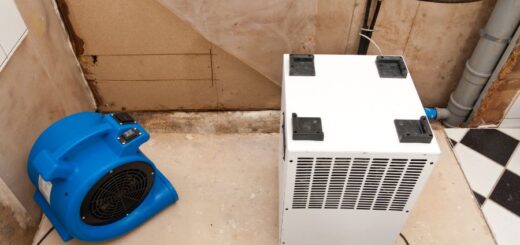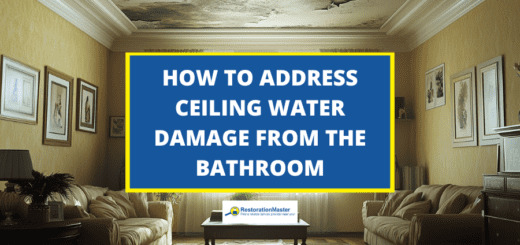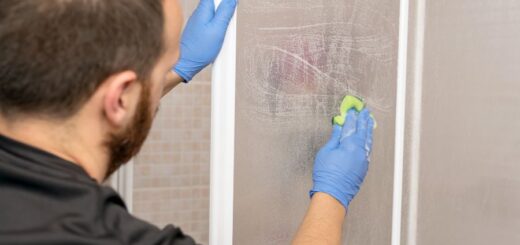How to Find a Water Leak Under Concrete Slab
Summary: Slab leaks are a distressing issue that occur when pipes within a concrete foundation develop cracks or leaks. The reasons behind water leaks under concrete slabs include high or low water pressure, earthquakes, poor construction, soil conditions, age of the home, chemical reactions, and the porousPorous describes a material that contains small openings or ... More nature of concrete. The consequences of such leaks include water damage, moldMold is a type of fungus that grows in damp or humid conditi... More growth, flooring destruction, bad odors, and structural issues. The seven most common warning signs of a slab leak include increased water bills, weak water pressure, warm spots on the floor, pooling water, wet or damp floors, soggy carpets, and new cracks in walls or floors. Identifying and addressing these issues promptly is important.
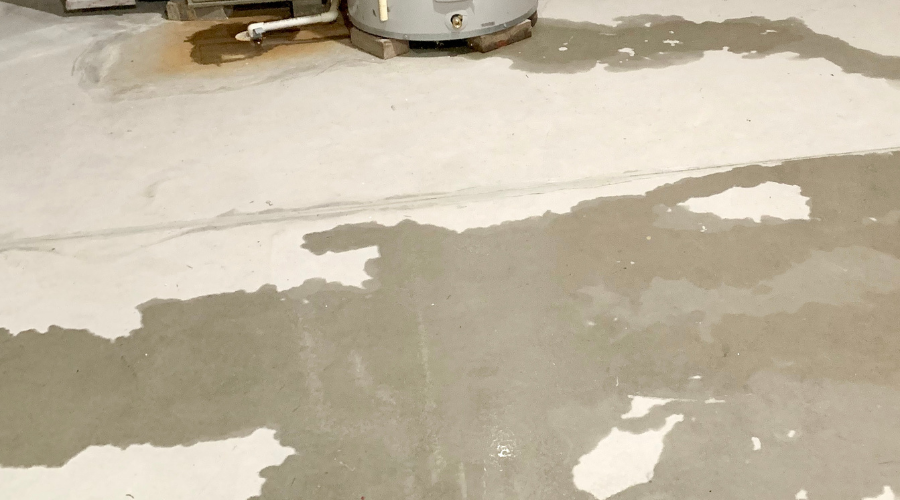
Water Leak Under Concrete Slab
Waking up to water creeping through your home’s floors can be a distressing sight, indicating a problem lurking beneath the surface. Slab leaks, a prevalent plumbing issue, arise when pipes embedded within the concrete foundation develop leaks or cracks. These concealed leaks present a serious threat, potentially resulting in water damage, moldMold is a type of fungus that grows in damp or humid conditi... More growth, and structural compromise.
Here, we’ll talk about why water leaks happen under concrete, what problems they can cause, and how to find them. We’ll also cover ways to find these leaks and fix them before they get worse.
What Leads to Water Leak Under Concrete Slab?
Water leaks beneath concrete slab can happen for a few reasons:
- Incorrect water pressure: When the water pressure is too high, it strains the pipes, making them prone to leaks. On the flip side, low pressure can cause sediment buildup, leading to corrosion and eventual leaks.
- Earthquakes: When there’s an earthquake, the ground moves, and that movement can damage the pipes, leading to leaks under the concrete.
- Poor construction: Sometimes, if the pipes weren’t installed properly or if low-quality materials were used during construction, it can increase the chances of leaks happening.
- Soil conditions: The type of soil underneath can play a role. If the soil expands and contracts a lot or if it’s corrosive, it can put pressure on the pipes, causing them to crack or break.
- Age of the home: As homes get older, so do the pipes. Over time, they can corrode or wear out, making leaks more likely.
- Chemical reactions: Sometimes, chemical reactions within the pipes or between the pipes and surrounding materials can weaken them, leading to leaks.
- The PorousPorous describes a material that contains small openings or ... More Nature of Concrete: Concrete is porousPorous describes a material that contains small openings or ... More, meaning it can absorb water over time. If there are leaks in nearby pipes, the water can seep into the concrete, exacerbating the problem.
The Consequences of Water Leaks Beneath Concrete
The water leaks under the concrete slab can cause the following issues, such as:
- Water Damage: The leaks can damage your belongings and property as a whole, resulting in the need for costly repairs and restorationRestoration is the process of returning a property to its pr... More services.
- MoldMold is a type of fungus that grows in damp or humid conditi... More Growth: The excess moisture from leaks creates the perfect atmosphere for moldMold is a type of fungus that grows in damp or humid conditi... More and mildewMildew is a type of fungus that grows on damp surfaces, typi... More to grow. Besides damaging your property, these fungiFungi are a group of organisms, including mold, mildew, and ... More can also pose health risks, triggering allergies and respiratory problems.
- Destroyed Flooring: A constant exposure to water can really mess up your floors, causing them to warp, buckle, or get stained. And once that happens, you usually have to replace the flooring altogether.
- Bad OdorAn odor is a smell, often detectable by the human nose, whic... More: When water sits still and moldMold is a type of fungus that grows in damp or humid conditi... More starts growing, it can make your home smell really bad, spreading an unpleasant odorAn odor is a smell, often detectable by the human nose, whic... More everywhere and making it hard to live comfortably.Top of Form
- Structural Issues: If water sticks around for a long time, it can cause big problems for your home’s structureStructure refers to the framework or components of a buildin... More. Things like sagging or shifting of the building’s framework can happen, and you need to deal with them right away to stop more damage or even collapse.
Common Warning Signs of a Slab leak
Here are seven signs that indicate you might have a water leak under your concrete slab:
- Rise in Water Bills: If your water bills suddenly shoot up without a logical explanation, it could mean water is leaking somewhere.
- Weak Water Pressure: Do your faucets or showerheads seem to be dribbling rather than flowing? This drop in water pressure might signal a leak diverting water away from your taps.
- Warm Spots on Floor: Are certain areas of your floor unexpectedly warm? This could mean a hot water pipe beneath the slab is leaking.
- Pooling Water: If you’re seeing puddles of water where they shouldn’t be, especially on your floor, it’s a clear sign that something’s leaking.
- Wet or Damp Floors: Feeling moisture underfoot or noticing that your floors seem consistently damp or wet, suggests water may be seeping up from underneath the concrete slab.
- Soggy Carpets: If your carpets feel consistently damp or soggy, despite no obvious spills or leaks, it could be a sign that water is wicking up from the concrete slab below.
- New Cracks in Walls or Floors: Unexpected cracks appearing in your walls or concrete floors could indicate a water seepageSeepage is the slow movement of water or other fluids throug... More under the slab.
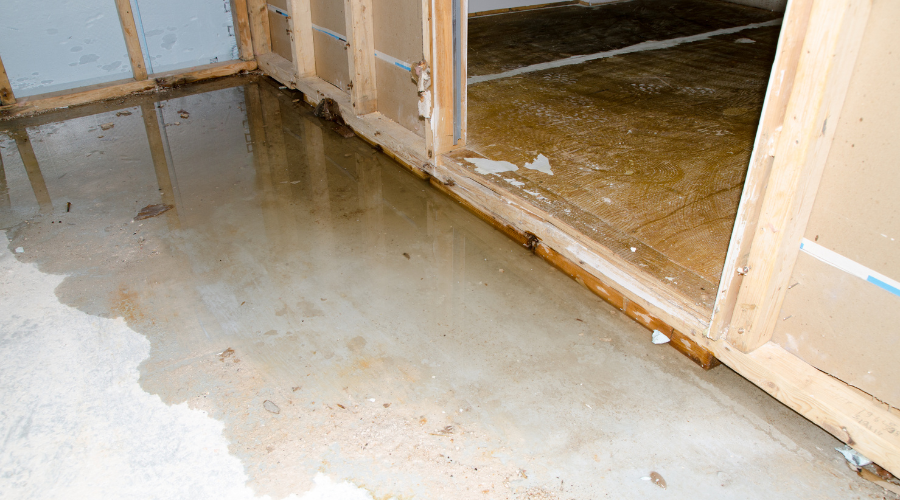
How to Repair the Water leak Under the Concrete Slab
If you suspect there’s a leak under your concrete slab, it’s important to contact a water damage restoration expert right away. They have the specialized tools and skills to quickly identify the leak’s location using advanced equipment like electronic listening devices and line-tracing tools.
Here’s how the concrete water leaks are repaired:
- Trenchless Slab Leak RepairRepair is the act of fixing or restoring damaged property, m... More: Trenchless slab leak repairRepair is the act of fixing or restoring damaged property, m... More is a method that involves fixing the leak without having to dig up the entire slab. This is often the preferred method as it minimizes disruption to your property. The process typically involves creating small access points through the slab, either by drilling or using other methods, to reach the leaking pipe. Once the access points are established, specialized equipment is used to repairRepair is the act of fixing or restoring damaged property, m... More the leak. This can include methods such as epoxy pipelining or pipe bursting. Epoxy pipe lining involves coating the inside of the damaged pipe with an epoxy resin, effectively sealing off the leak. Pipe bursting involves breaking apart the old pipe while simultaneously pulling a new pipe into place.
- Pipe Re-Piping or Re-Routing: In some cases, it may be necessary to replace the damaged pipe entirely. This is often the case if the pipe is old and prone to multiple leaks or if the damage is extensive. Pipe re-piping involves removing the damaged section of pipe and replacing it with a new one. This can be done either by accessing the pipe through the slab or by rerouting the pipe through walls or ceilings. Rerouting the pipe may be necessary if the damaged section of pipe is difficult to access or if there are other obstacles in the way. This involves installing new pipes in a different location to bypass the damaged area.
- Tunneling Under the Slab: If the leak is located in a particularly difficult-to-reach area or if other methods are not feasible, tunneling under the slab may be necessary. Tunneling involves digging a trench underneath the slab to access the leaking pipe. This can be a more invasive and costly method, but it may be necessary in certain situations. Once the leak is repaired, the trench is filled back in, and the slab is restored to its original condition as much as possible.
Contact RestorationMaster for Water Damage Restoration

You’re not alone in facing the challenges of water damage from concrete water leaks. At RestorationMaster, we understand the stress that comes with seeing your home affected by such issues. Water damage restoration professionals specialize in addressing water damage, especially from slab leaks. They will diligently identify the root cause of the problem and then restore your home to its original state.
Whether it’s dryingDrying is the process of removing moisture from materials, s... More out affected areas or thoroughly cleaning up, they can handle every step of the process with care and attention.










